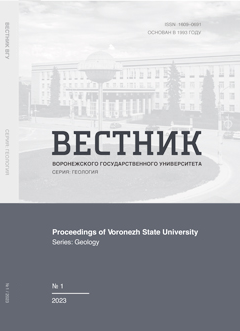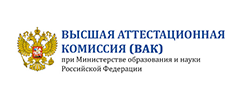Полосчатые железистые кварциты главной рудной толщи Костомукшского зеленокаменного пояса Карельского кратона: геохимия, петрография и условия формирования
Аннотация
Введение: Полосчатые железистые формации (BIF) являются метаморфизованными хемогенными осадками, накопление которых происходило в раннем докембрии. Выделяют BIF двух типов: Aлгома и Cьюпериор. Одним из проявлений BIF типа Алгома является Костомукшский зеленокаменный пояс, в котором выделяется четыре ассоциации BIF, из которых неоархейские (BIF-3) характеризуются наибольшей мощностью и протяжённостью. Особенности распределения петрогенных, редких и рекоземельных элементов являются надёжным индикатором условий, в которых происходило накопление BIF.
Методика: Химический состав проб определялся на рентгено-флуоресцентном спектрометре S8 Tiger (Bruker AXS GmbH, Германия) в Воронежском госуниверситете. Малые и редкие элементы определяли методом индукционно-связанной плазмы с масс-спектрометрическим окончанием анализа (ICP-MS) в АСИЦ ИПТМ РАН.
Результаты и обсуждение: Неоархейские железистые формации (2.76–2.74 млрд лет) (BIF-3) в Костомукшском зеленокаменном поясе имеют тёмную окраску и полосчатую текстуру с чередованием слоёв, обогащённых кварцем и магнетитом. Сумма SiO2 и Fe2O3tot составляет 83–98 %. В BIF-3 отмечается повышенное содержание K2O (0.12–2.9 мас. %), при этом содержания других петрогенных оксидов сопоставимо с другими архейскими BIF Алгома. Содержания высокозарядных элементов очень низкие и изменчивые, но отмечаются повышенные концентрации Rb (1.4–111 ppm) и Ba (6.5‒799 ppm). Обогащение HREE относительно LREE ((La/Yb)SN=0.21–1.17), положительные La/La* и YSN аномалии и суперхондритовое отношение Y/Ho (31–42) свидетельствуют о накоплении BIF-3 в морских условиях. Положительные Eu/Eu* аномалии свидетельствуют о гидротермальном привносе, как основном источнике Si, Fe и Mn в BIF. Отсутствие отрицательных Ce/Ce* аномалий (0.9–1.04) и низкие концентрации U указывают, что накопление происходило в условиях дефицита кислорода в атмосфере, до Великого Окислительного события (GOE~2.4–2.2 млрд лет назад). Низкие содержания хрома и молярные отношения Ni/Fe (0.04–0.57х10-4), отсутствие корреляции между MgO и Cr, слабая корреляция между MgO и Ni указывают на отсутствие в источниках сноса пород ультраосновного и основного составов, а сильные положительные корреляции Al2O3 с Zr и REE, TiO2 с Zr, а также Hf с Zr указывают на преобладание в источниках сноса пород кислого состава.
Выводы: Образование BIF-3 происходило в морском бассейне в условиях дефицита кислорода, что предполагает их образование до Великого Окислительного события. Si, Fe и Mn поступали, в основном, из гидротермальных источников. Характер распределения терригенной примеси Al2O3, TiO2, Zr и Hf указывают на источники сноса с преобладанием гранитоидов.
Скачивания
Литература
2. Bekker A., Slack J. F., Planavsky N., Krapez B., Hofmann A., Konhauser K. O., Rouxel O. J. Iron Formation: The Sedimentary Product of a Complex Interplay among Mantle, Tectonic, Oceanic, and Biospheric. Econ. Geol, 2010, vol. 105, pp. 467–508. DOI: 10.2113/gsecongeo.105.3.467
3. Klein C. Some Precambrian banded iron-formations (BIFs) from around the world: Their age, geologic setting, mineralogy, metamorphism, geochemistry, and origin. American Mineralogist, 2005, vol. 90, pp. 1473–1499. DOI: 10.2138/am.2005.1871
4. Simonson B. M. Origin and evolution of large Precambrian iron formations Geological Society of America, 2003, vol. 370. pp. 231–244. DOI: 10.1130/0-8137-2370-1.231
5. Holland H. D. Sedimentary Mineral Deposits and the Evolution of Earth’s Near-Surface Environments. Econ. Geol, 2005, vol. 100, pp. 1489-1509. DOI: 10.2113/gsecongeo.100.8.1489
6. Pecoits E., Gingras M. K., Barley M. E., Kappler A., Posth N. R., Konhauser K. O. Petrography and geochemistry of the Dales Gorge banded iron formation: Paragenetic sequence, source and implications for paleo-ocean chemistry. Precambrian Re, 2009, vol. 172, pp. 163–187. DOI: 10.1016/j.precamres.2009.03.014
7. Bekker A., Planavsky N. J., Krapez B., Rasmussen B., Hofmann A., Slack J. F., Rouxel O. J., Konhauser K. O. Iron formations: Their origins and implications for ancient seawater chemistry. Treatise on Geochemistry, 2014, vol. 9, pp. 561‒628. DOI: 10.1016/B978-0-08-095975-7.00719-1
8. Gross G. A. A classification of iron formation based on depositional environments. Canadian Mineralogist, 1980, vol. 18, pp. 215‒222.
9. Gole M. J., Klein C. Banded iron formation through much Precambrian time // Journal of Geology. 1981. Vol. 89 (2). pp. 169‒183. DOI: 10.1086/628578
10. Fryer B. J. Rare Earth Elements in Iron-Formation. Development in Precambrian Geology, 1983, ch. 8B, pp. 345‒358. DOI: 10.1016/S0166-2635(08)70048-3
11. Savko A. D., Shevyrjov L. T. Zhelezisto-kremnistye formacii kontinentov – novye istoriko-mineragenicheskie dannye o rasprostranenii, vozraste, genezise. Stat'ja 1. Osadochnye bassejny s ZhKF [Ferrous-siliceous formations of continents - new historical and mineragenic data on distribution, age, genesis. Article 1. Sedimentary basins with LCF]. Vestnik Voronezhskogo gosudarstvennogo universiteta. Seriya: Geologiya. – Proceedings of Voronezh State University. Series: Geology, 2017, no. 3, pp. 5‒17 (In Russ.)
12. Gor'kovec V. Ja., Raevskaja M. B., Belousov E. F., Inina K. A. Geologija i metallogenija rajona Kostomukshskogo zhelezorudnogo mestorozhdenija [Geology and metallogeny of the Kostomuksha iron ore deposit area]. Petrozavodsk, Karel publ., 1981. 143 p. (In Russ.)
13. Slabunov A. I., Nesterova N. S., Egorov A. V., Kuleshevich L. V., Kevlich V. I. Geohimija, geohronologija cirkonov i vozrast arhejskoj zhelezorudnoj tolshhi Kostomukshskogo zelenokamennogo pojasa Karel'skogo kratona Fennoskandinavskogo shhita [Age of the Archean Strata with Banded Iron Formation in the Kostomuksha Greenstone Belt, Karelian Craton, Fennoscandian Shield: Constraints on the Geochemistry and Geochronology of Zircons]. Geohimija ‒ Geochemistry, 2021, vol. 59, no. 4, pp. 341‒356. DOI: 10.1134/S0016702921040066
14. Slabunov A. I., Nesterova N. S., Maksimov O. A. Geochemistry and Formation Conditions of Mesoarchean Banded Iron Formations (BIF-1) from the Kostomuksha Greenstone Belt, Karelian Craton. Geochemistry International, 2024, vol. 62, no. 3, pp. 245–266. DOI: 10.1134/S0016702924030054
15. Slabunov A. I., Kervinen A. V., Nesterova N. S., Egorov A. V., Maksimov O. A., Medvedev P. V. Glavnye jepizody formirovanija poloschatyh zhelezistyh kvarcitov Kostomukshskogo zelenokamennogo pojasa (Karel'skij kraton): dannye U-Th-Pb datirovanija cirkona [The main episodes of the formation of banded ferruginous quartzites of the Kostomuksha greenstone belt (Karelian craton): U-Th-Pb zircon dating data]. Trudy Karel'skogo nauchnogo centra RAN. ‒ Proceedings of the Karelian Scientific Center of the Russian Academy of Sciences, 2023, vol. 2, pp. 5‒2 (In Russ.) DOI: 10.17076/geo1749
16. Slabunov A.I., Nesterova N.S., Kervinen A.V., Maksimov O.A., Medvedev P.V. Poloschatye zhelezistye kvarcity kak arhiv tektono-termal'noj istorii (na primere Kostomukshskogo zelenokamennogo kompleksa) [Banded ferruginous quartzites as an archive of tectonothermal history (using the example of the Kostomuksha greenstone complex)]. Stratigrafija dokembrija: problemy i puti reshenija: materialy konferencii [Precambrian stratigraphy: problems and solutions: conference proceedings: materials of the meeting]. Saint Petersburg, September 25‒29, 2023, Institute of Precambrian Geology and Geochronology, Svoe izdatel'stvo publ., 2023, pp. 143‒145 (In Russ.)
17. Slabunov A.I., Lobach-Zhuchenko S.B., Bibikova E.V., Balaganskij V.V., Sor'onen-Vard P., Volodichev O.I., Shhipanskij A.A., Svetov S.A., Chekulaev V.P., Arestova N.A., Stepanov V.S. Arhej Baltijskogo shhita: geologija, geohronologija, geodinamicheskie obstanovki [Archean of the Baltic Shield: geology, geochronology, geodynamic settings]. Geotektonika. – Geotectonics, 2006, vol. 6, pp. 1‒29 (In Russ.)
18. Samsonov A.V., Stepanova A.V., Sal'nikova E.B., Larionova Ju.O., Larionov A.N. Geodinamika raskola zapadnoj chasti Karel'skogo kratona: dannye po osnovnomu magmatizmu 2.1 mlrd let [Geodynamics of the breakup of the western part of the Karelian craton: data on the main magmatism at 2.1 Ga]. Petrologija.‒ Petrology, 2023, vol. 31, no. 6, pp. 577‒601 (In Russ.) DOI: 10.31857/S0869590323060092
19. Hölttа P., Heilimo E., Huhma H. Kontinen A., Mertanen S., Mikkola P., Paavola J., Peltonen P., Semprich J., Slabunov A., Sorjonen-Ward P. The Archaean Karelia and Belomorian Provinces, Fennoscandian Shield. In Evolution of Archean Crust and Early Life (Eds. Dilek Y., Furnes H.). Modern Approaches in Solid Earth Sciences, 2014, vol. 7, pp. 55‒102.
20. Chernov V. M., Stenar' M. M. Stratigrafija Karel'skih obrazovanij zapadnoj Karelii [Stratigraphy of the Karelian formations of western Karelia]. Trudy Karel'skogo filiala Akademii nauk SSSR. ‒ Proceedings of the Karelian Branch of the USSR Academy of Sciences, 1960, vol. XXVI, pp. 29‒45 (In Russ.)
21. Lobach-Zhuchenko S. B., Chekulaev V. P., Arestova N. A., Levskij L. K., Kovalenko A. B. Arhejskie terrejny Karelii: geologicheskoe i izotopno-geohimicheskoe obosnovanie [Archean terranes of Karelia: geological and isotope-geochemical substantiation]. Geotektonika. ‒ Geotectonics, 2000, vol. 6, pp. 26‒42 (In Russ.)
22. Slabunov A. I., Hjoltta P., Sharov N. V., Nesterova N. S. 4-D model' formirovanija zemnoj kory Fennoskandinavskogo shhita v arhee kak sintez sovremennyh geologicheskih dannyh [4-D model of the formation of the earth's crust of the Fennoscandian shield in the Archean as a synthesis of modern geological data. Geology of Karelia from the Archean to the present day]. Geologija Karelii ot arheja do nashih dnej: materialy konferencii [Geology of Karelia from Archaea to the present day: materials of the meeting]. Petrozavodsk, May 24‒26, 2011, Institute of Geology, KSC RAS publ., 2011, pp. 13‒21 (In Russ.)
23. Slabunov A. I., Svetov S. A., Stepanova A. V., Medvedev P. V., Polin A. K. Novaja tektonicheskaja karta Karelii: principy postroenija i ih realizacija [New tectonic map of Karelia: principles of construction and their implementation]. Trudy Karel'skogo nauchnogo centra RAN ‒ Proceedings of the Karelian Scientific Center of the Russian Academy of Sciences, 2022, vol. 5, pp. 132‒138 (In Russ.) DOI: 10.17076/geo1690
24. Kulikov V. S., Svetov S. A., Slabunov A. I., Kulikova V. V., Polin A. K., Golubev A. I., Gor'kovec V. Ja., Ivashhenko V. I., Gogolev M. A. Geologicheskaja karta Jugo-vostochnoj Fennoskandii masshtaba 1:750 000: novye podhody k sostavleniju [Geological map of Southeast Fennoscandia at a scale of 1:750 000: new approaches to compilation]. Trudy Karel'skogo nauchnogo centra RAN ‒ Proceedings of the Karelian Scientific Center of the Russian Academy of Sciences, 2017, vol. 2, pp. 3‒41 (In Russ.) DOI: 10.17076/geo444
25. Kozhevnikov V. N., Berezhnaja N. G., Presnjakov S. L., Lepehina E. N., Antonov A. V., Sergeev S. A. Geohronologija cirkona (SHRIMP-II) iz arhejskih stratotektonicheskih associacij v zelenokamennyh pojasah Karel'skogo kratona: rol' v stratigraficheskih i geodinamicheskih rekonstrukcijah [Zircon geochronology (SHRIMP-II) from Archean stratotectonic associations in greenstone belts of the Karelian Craton: role in stratigraphic and geodynamic reconstructions]. Stratigrafija. Geologicheskaja korreljacija ‒ Stratigraphy. Geological correlation, 2006, vol.14, no. 3, pp. 19‒41 (In Russ.)
26. Kuleshevich L. V., Furman V. N. Zolotorudnoe mestorozhdenie Talovejs v Kostomukshskoj dokembrijskoj zelenokamennoj strukture (Karelija) [Taloveis gold deposit in the Kostomuksha Precambrian greenstone structure (Karelia)]. Geologija rudnyh mestorozhdenij ‒ Geology of ore deposits, 2009, vol. 51, no. 1, pp. 58‒76 (In Russ.)
27. Lazarev Ju. I. Strukturnaja i metamorficheskaja petrologija zhelezistyh kvarcitov Kostomukshskogo mestorozhdenija Karel'skoj ASSR [Structural and metamorphic petrology of ferruginous quartzites of the Kostomuksha deposit of the Karelian Autonomous Soviet Socialist Republic]. Saint Petrsburg, Nauka publ., 1971, 192 p. (In Russ.)
28. Gor'kovec V. Ja., Sharov N. V. Kostomukshskij rudnyj rajon (geologija, glubinnoe stroenie i mineragenija) [Kostomuksha ore district (geology, deep structure and minerageny).]. Petrozavodsk, KarNC RAN publ., 2015, 322 p. (In Russ.)
29. Nesterova N. S., Slabunov A.I., Kervinen A. V., Maksimov O. A. Vozrast i osobennosti formirovanija mezoarhejskih BIF Kostomukshskogo zelenokamennogo pojasa, Karel'skij kraton, Fennoskandinavskij shhit [Age and features of the formation of Mesoarchean BIFs of the Kostomuksha greenstone belt, Karelian craton, Fennoscandian shield]. Geologicheskie processy v obstanovkah subdukcii, kollizii i skol'zhenija litosfernyh plit: materialy konferencii [Geological processes in the conditions of subduction, collision and sliding of lithospheric plates: proceedings of the conference with international participation: materials of the meeting]. Vladivostok, September 19‒22, 2023, Far East Geological Institute, FEFU publ., 2023, pp. 104‒107 (In Russ.)
30. Gor'kovec V. Ja., Raevskaja M. B., Volodichev O. I., Golovanova L. S. Geologija i metamorfizm zhelezisto-kremnistyh formacij Karelii [Geology and metamorphism of ferruginous-siliceous formations of Karelia]. Saint Petersburg, Nauka publ., 1991, 176 p. (In Russ.)
31. Slabunov A. I., Egorov A. V., Nesterova N. S. Geochemical types of Archean banded iron formations and the geodynamic settings of the basins, Kostomuksha Greenstone Belt, Karelian Craton, Russia. Sedimentary Earth Systems: Stratigraphy, Geochronology, Petroleum Resources. Kazan, CFU publ., 2020, pp. 256‒262.
32. Mil'kevich R.I., Myskova T. A. Pozdnearhejskie metaterrigennye porody Zapadnoj Karelii (litologija, geohimija, istochniki snosa) [Late Archean metaterrigenous rocks of Western Karelia (lithology, geochemistry, provenance sources)]. Litologija i poleznye iskopaemye ‒ Lithology and minerals, 1998, vol. 2, pp. 177‒194 (In Russ.)
33. Savko K. A., Bazikov N. S., Artemenko G. V. Geohimicheskaja jevoljucija zhelezisto-kremnistyh formacij Voronezhskogo kristallicheskogo massiva v rannem dokembrii: istochniki veshhestva i geohronologicheskie ogranichenija [Geochemical evolution of ferruginous-siliceous formations of the Voronezh crystalline massif in the Early Precambrian: sources of matter and geochronological restrictions]. Stratigrafija. Geol. Korreljacija – Stratigraphy. Geologic correlation, 2015, vol. 23, no. 5, pp. 3‒21 (In Russ.) DOI: 10.7868/S0869592X15050063
34. Haugaard R., Frei R., Stendal H., Konhauser K. Petrology and geochemistry of the ~2.9 Ga Itilliarsuk banded iron formation and associated supracrustal rocks, West Greenland: Source characteristics and depositional environment. Precambr. Res, 2013, vol. 229, pp. 150‒176. DOI: 10.1016/j.precamres.2012.04.013
35. Haugaard R., Ootes L., Creaser R. A., Konhauser K. The nature of Mesoarchaean seawater and continental weathering in 2.85 Ga banded iron formation, Slave craton, NW Canada. Geochim. Cosmochim. Acta, 2016, vol. 194, pp. 34‒56. DOI: 10.1016/j.gca.2016.08.020
36. Zhou H., Zhou W., Wei Y., Fru E. C., Huang B., Fu D., Li H., Tan M. Mesoarchean banded iron-formation from the northern Yangtze Craton, South China and its geological and paleoenvironmental implications. Precambr. Res, 2022, vol. 383, 106905. DOI: 10.1016/j.precamres.2022.106905
37. Lan T. G., Fan H. R., Santosh M., Hu F. F., Yang K. F., Liu Y. S. U-Pb zircon chronology, geochemistry and isotopes of the Changyi banded iron formation in the eastern Shandong Province: Constrains on BIF genesis and implications for Paleoproterozoic tectonic evolution of the North China Craton. Ore Geology Reviews, 2014, vol. 56, pp. 472‒486. DOI: 10.1016/j.oregeo¬rev.2013.06.008
38. Gross G. A., McLeod C. R. A preliminary assessment of the chemical composition of iron formation in Canada. Canadian Mineralogis, 1980, vol. 18, pp. 223‒229.
39. Condie K. C. Chemical composition and evolution of the upper continental crust: Contrasting results from surface samples and shales. Chemical Geology, 1993, vol. 104, pp. 1‒37. DOI: 10.1016/0009-2541(93)90140-E
40. Moon I., Lee I., Yang X. Geochemical constraints on the genesis of the Algoma-type banded iron formation (BIF) in Yishui County, western Shandong Province, North China Craton. Ore Geology Reviews, 2017, vol. 89, pp. 931‒945. DOI: 10.1016/j.oregeorev.2017.08.005
41. Alexander B. W., Bau M., Andersson P., Dulski P. Continentally-derived solutes in shallow Archean seawater: Rare earth element and Nd isotope evidence in iron formation from the 2.9 Ga Pongola Supergroup, South Africa. Geochim. Cosmochim. Acta, 2008, vol. 72, pp. 378‒394. DOI: 10.1016/j.gca.2007.10.028
42. Mloszewska A. M., Pecoits E., Cates N. L., Mojzsis S. J., O’Neil J., Robbins L. J., Konhauser K. O. The composition of Earth’s oldest iron formations: The Nuvvuagittuq Supracrustal Belt (Quebec, Canada). Earth and Planetary Science Letters, 2012, pp. 331‒342. DOI: 10.1016/j.epsl.2011.11.020
43. Konhauser K. O., Pecoits E., Lalonde S. V., Papineau D., Nisbet E. G., Barley M. E., Arndt N.T., Zahnie K., Kamber B. S. Oceanic nickel depletion and a methanogen famine before the Great Oxidation Event. Nature, 2009, vol. 458(7239), pp. 750–753. DOI:10.1038/nature07858
44. Konhauser K. O., Lalonde S. V., Planavsky N. J., Pecoits E., Lyons, T. W., Mojzsis S. J., Rouxel O. J., Barley M. E., Rosiere C., Fralick P. W., Kump L. R., Bekker A. Aerobic bacterial pyrite oxidation and acid rock drainage during the Great Oxidation Event. Nature, 2011, vol. 478(7369), pp. 369–373. DOI:10.1038/nature10511
45. Taylor S. R., McLennan S. M. The Continental Crust: Its Composition and Evolution. Oxford: Blackwell, 1985. 312 p.
46. Partin C. A., Lalonde S. V., Planavsky N. J., Bekker A., Rouxel O., Lyons T. W., Konhauser K. Uranium in iron formations and the rise of atmospheric oxygen. Chem. Geol, 2013,vol. 362, pp. 82–90. DOI: 10.1016/j.chemgeo.2013.09.005
47. Huang B., Kusky T. M., Wang L., Deng H., Wang J., Fu D., Peng H., Ning W. Age and genesis of the Neoarchean Algoma-type banded iron formations from the Dengfeng greenstone belt, southern North China Craton: Geochronological, geochemical and Sm–Nd isotopic constraints. Precambrian Research, 2019, vol. 333, 105437. DOI: 10.1016/j.precamres.2019.105437
48. Stern R. J., Mukherjee S. K., Miller N. R., Ali K., Johnson P. R. ∼750 Ma banded iron formation from the Arabian-Nubian Shield—Implications for understanding neoproterozoic tectonics, volcanism, and climate change. Precambr. Res, 2013, vol. 239, pp. 79‒94. DOI: 10.1016/j.precamres.2013.07.015
49. Dymek R. F., Klein C. Chemistry, petrology and origin of banded iron-formation lithologies from the 3800 Ma Isua Supracrustal Belt, West Greenland. Precambrian Res, 1988, vol. 39, pp. 247‒302. DOI: 10.1016/0301-9268(88)90022-8
50. Wonder J. D., Spry P. G., Windom K. E. Geochemistry and origin of manganese-rich rocks related to iron-formation and sulfide deposits, western Georgia. Econ. Geol, 1988, vol. 83, pp. 1070‒1081. DOI: 10.2113/gsecongeo.83.5.1070
51. Bolhar R., Kamber B. S., Moorbath S., Fedo C. M., Whitehouse M. J. Characterisation of early Archaean chemical sediments by trace element signatures. Earth Planet. Sci. Lett, 2004, vol. 222, no. 1, pp. 43‒60. DOI: 10.1016/j.epsl.2004.02.016
52. Kamber B. S., Webb G. E. The geochemistry of late Archean microbial carbonate: Implications and continental erosion history. Geochimica et Cosmochimica Acta, 2001, vol. 65, no. 15, pp. 2509‒2525. DOI: 10.1016/S0016-7037(01)00613-5
53. Bau. M., Dulski P. Comparing yttrium and rare earths in hydrothermal fluids from the Mid-Atlantic Ridge: implications for Y and REE behaviour during near-vent mixing and for the Y/Ho ratio of Proterozoic seawater. Chemical Geology, 1999, vol. 155, pp. 77‒90. DOI: 10.1016/S0009-2541(98)00142-9
54. Bau M., Dulski P. Distribution of yttrium and rare-earth elements in the Penge and Kuruman iron-formations, Transvaal supergroup, South Africa. Precambrian Research, 1996, vol. 79, pp. 37‒55. DOI: 10.1016/0301-9268(95)00087-9
55. Planavsky N., Bekker A., Rouxel O. J., Kamber B., Hofmann A., Knudsen A., Lyons T. W. Rare Earth Element and Yttrium Compositions of Archean and Paleoproterozoic Fe Formations Revisited: New Perspectives on the Significance and Mechanisms of Deposition. Geochimica et Cosmochimica Acta, 2010, vol. 74, pp. 6387‒6405. DOI: 10.1016/j.gca.2010.07.021













